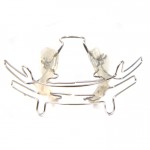
Obstructive sleep apnoea (OSA) can result in day-time sleepiness, neurocognitive decline and, in the long terms cardiovascular problems. While nasal continuous positive airway pressure (CPAP) is the standard treatment for OSA oral appliances (OAs) have been used as an alternative approach. The aim of this review was to assess the effectiveness of OAs that advanced the mandible forward and limited mouth opening on OSA.
Searches were conducted in Medline, the Cochrane Central Register of Controlled Trials and Japan Medical Abstracts Society databases. In addition the reference lists of included articles were searched without language restrictions. Three reviewers carried out study selection and data abstraction independently. Only randomised controlled trials (RCTs) were included. Outcomes of interest were: severity of sleep-disordered breathing [as measured by the Apnea Hypopnoea Index (AHI), lowest SpO2 and the arousal index in polysomnography]. Subjective daytime sleepiness [as measured by the Epworth Sleepiness Scale (ESS)], sleep-related quality of life (as measured by General Health, Mental Health and Vitality components of the SF-36 Health Survey). The GRADE approach was used to assess overall evidence quality.
- 5 studies were included with follow up periods ranging from 4 weeks to 6 months
- Comparing OA and control appliance,
- OA significantly reduced the weighted mean difference in both AHI (-7·05 events h_1; 95% CI, -12·07 to -2·03; P = 0.006) and the arousal index (-6·95 events h_1; 95% CI, -11·75 to -2·15; P = 0_005).
- No significant difference was observed in ESS, SF-36 General Health, Mental Health or Vitality
- Comparing OA and CPAP
- OAs were significantly less effective at reducing the weighted mean difference in AHI (6·11 events h(-1) ; 95% CI, 3·24 to 8·98; P = 0·0001) and improving lowest SpO2 ( -2·52%; 95% CI, -4·81 to -0·23; P = 0·03) and SF-36 Mental Health (-1·80; 95% CI, -3·17 to -042; P = 0·01) than CPAP.
The authors concluded
Apnea Hypopnoea Index and the arousal index were significantly improved by OA therapy relative to the untreated disease. Apnea Hypopnoea Index, lowest SpO2 and QOL were significantly better with CPAP therapy than with OA therapy.
Comments
As the authors note there have been other systematic reviews in this area (see links) that had similar findings to this new review. However the authors do point out that the findings a limited due to the small number of weak studies. The 2006 Cochrane review ( Lim et al) has a broader remit and included 17 studies and concluded
Although the data are limited by the relatively small number of patients studied and methodological weaknesses, such as lack of blinding, there is increasing evidence that OA improves subjective sleepiness and indices of sleep disordered breathing over an inactive control.
As this included studies in the new review as still small and have important methodological weaknesses there is still clearly a need to see the results from larger higher quality trials in this area.
Links
Okuno K, Sato K, Arisaka T, Hosohama K, Gotoh M, Taga H, Sasao Y, Hamada S. The effect of oral appliances that advanced the mandible forward and limited mouth opening in patients with obstructive sleep apnea: A systematic review and meta-analysis of randomised controlled trials. J Oral Rehabil. 2014 Jul;41(7):542-54. doi: 10.1111/joor.12162. Epub 2014 Mar 21. PubMed PMID: 24650215.
Dental Elf -6th March 2014 – Mandibular advancement devices for obstructive sleep apnoea
Health Quality Ontario. Oral appliances for obstructive sleep apnea: an evidence-based analysis. Ont Health Technol Assess Ser. 2009;9:1–51.
Lim J, Lasserson TJ, Fleetham J, Wright JJ. Oral appliances for obstructive sleep apnoea. Cochrane Database of Systematic Reviews 2006, Issue 1. Art. No.: CD004435. DOI: 10.1002/14651858.CD004435.pub3.

“@TheDentalElf: Review finds oral appliances improve some OSA indicators http://t.co/DXUmw1Xjqr” @BSDSM @SleepProSnoring @sleepgs
[…] Dental Elf – 18th July 2014 – Review finds that oral appliances produce improvements i… […]
[…] Dental Elf -18th Jul – Review finds that oral appliances produce improvements in some obstruct… […]